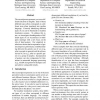Free Online Productivity Tools
i2Speak
i2Symbol
i2OCR
iTex2Img
iWeb2Print
iWeb2Shot
i2Type
iPdf2Split
iPdf2Merge
i2Bopomofo
i2Arabic
i2Style
i2Image
i2PDF
iLatex2Rtf
Sci2ools
SIGDIAL
2010
2010
Hand Gestures in Disambiguating Types of You Expressions in Multiparty Meetings
The second person pronoun you serves different functions in English. Each of these different types often corresponds to a different term when translated into another language. Correctly identifying different types of you can be beneficial to machine translation systems. To address this issue, we investigate disambiguation of different types of you occurrences in multiparty meetings with a new focus on the role of hand gesture. Our empirical results have shown that incorporation of gesture improves performance on differentiating between the generic use of you (e.g., refer to people in general) and the referential use of you (e.g., refer to a specific person or a group of people). Incorporation of gesture can also compensate for limitations in automated language processing (e.g., reliable recognition of dialogue acts) and achieve comparable results.
| Added | 15 Feb 2011 |
| Updated | 15 Feb 2011 |
| Type | Journal |
| Year | 2010 |
| Where | SIGDIAL |
| Authors | Tyler Baldwin, Joyce Yue Chai, Katrin Kirchhoff |
Comments (0)

